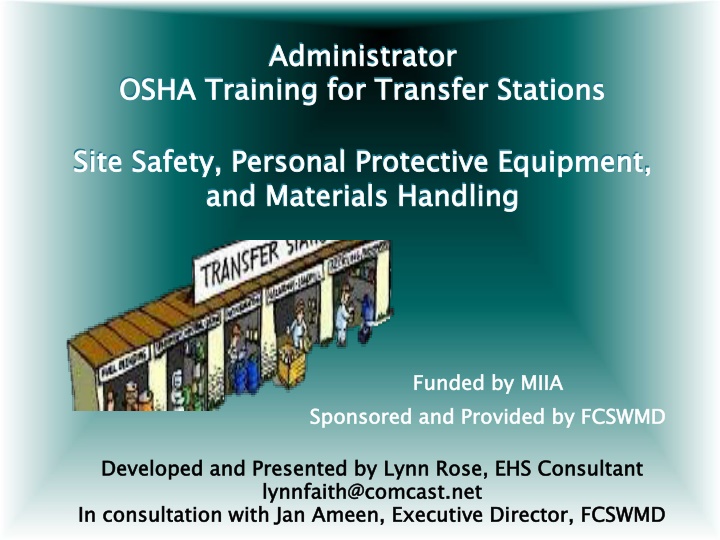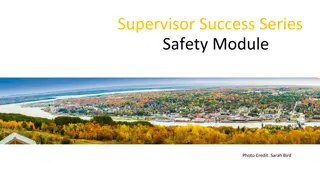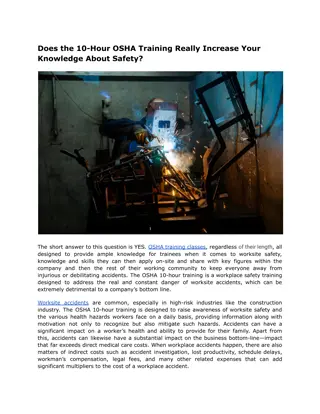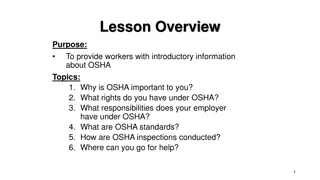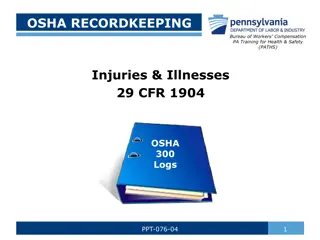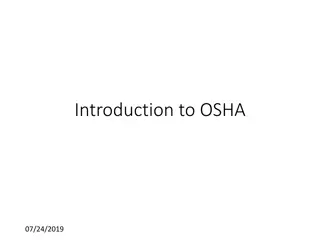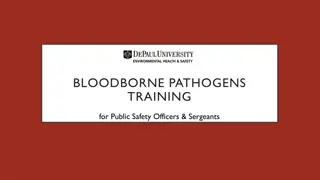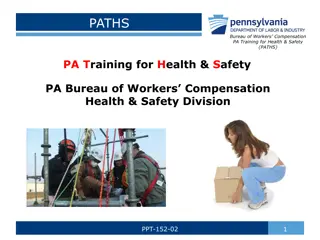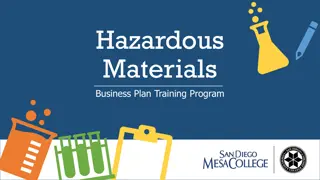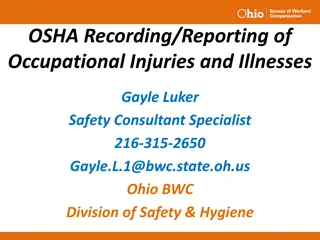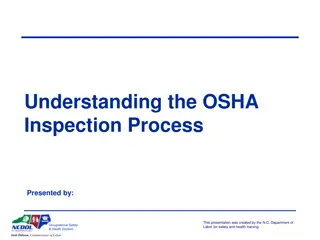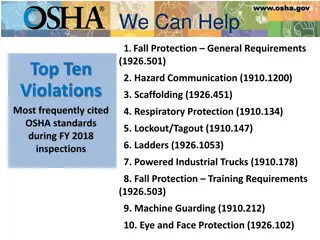OSHA Training for Transfer Stations: Site Safety and Materials Handling
This training session on OSHA requirements for transfer stations covers site safety, personal protective equipment, and materials handling. Developed and presented by EHS Consultant Lynn Rose in collaboration with FCSWMD Executive Director Jan Ameen, the training emphasizes work zone/site safety, PPE, and proper materials handling practices. Traffic concerns, visibility issues, and OSHA guidance on work zone safety are addressed to ensure the safety of attendants and workers at transfer stations.
Download Presentation

Please find below an Image/Link to download the presentation.
The content on the website is provided AS IS for your information and personal use only. It may not be sold, licensed, or shared on other websites without obtaining consent from the author.If you encounter any issues during the download, it is possible that the publisher has removed the file from their server.
You are allowed to download the files provided on this website for personal or commercial use, subject to the condition that they are used lawfully. All files are the property of their respective owners.
The content on the website is provided AS IS for your information and personal use only. It may not be sold, licensed, or shared on other websites without obtaining consent from the author.
E N D
Presentation Transcript
Administrator Administrator OSHA Training for Transfer Stations OSHA Training for Transfer Stations Site Safety, Personal Protective Equipment, and Materials Handling Site Safety, Personal Protective Equipment, and Materials Handling Funded by MIIA Funded by MIIA Sponsored and Provided by FCSWMD Sponsored and Provided by FCSWMD Developed and Presented by Lynn Rose, EHS Consultant lynnfaith@comcast.net In consultation with Jan Ameen, Executive Director, FCSWMD Developed and Presented by Lynn Rose, EHS Consultant lynnfaith@comcast.net In consultation with Jan Ameen, Executive Director, FCSWMD
1. 1. Work Zone/Site Safety Work Zone/Site Safety 2. 2. Personal Protective Equipment (PPE) Personal Protective Equipment (PPE) 3. 3. Materials Handling Materials Handling
Work Zone/ Site Safety Work Zone/ Site Safety This section builds on Administrative Session 2 information on incorporating emergency response guidance on a site map of the transfer station. This section builds on Administrative Session 2 information on incorporating emergency response guidance on a site map of the transfer station.
Traffic concerns at the TS examples: Unclear direction of traffic flow Lack of designated parking areas Unclear pedestrian walkways to disposal containers Speeding Traffic concerns at the TS - - examples: Unclear direction of traffic flow Lack of designated parking areas Unclear pedestrian walkways to disposal containers Speeding 4
Visibility Attendants, residents and vehicles moving around site at the same time Inadequate in buildings (lack of electricity) throughout site VisibilityConcerns: Attendants, residents and vehicles moving around site at the same time Inadequate lighting: in buildings (lack of electricity) throughout site Concerns: lighting: 5
There is no established work zone safety standard under the OSHA which governs municipalities. There is no established work zone safety standard under the OSHA General Industry Standards which governs municipalities. General Industry Standards, , There is guidance under the OSHA There is guidance under the OSHA Construction Standard Construction Standard: : It specifically refers to work zone safety for roadway work and construction sites. It specifically refers to work zone safety for roadway work and construction sites. Since DLS and MIIA are concerned about attendants being struck by vehicles, we have excerpted relevant guidance from the OSHA Since DLS and MIIA are concerned about attendants being struck by vehicles, we have excerpted relevant guidance from the OSHA Construction Standard Construction Standard. .
It would fall under the: OSH Act of 1970 Section 5(a)(1): General It would fall under the: OSH Act of 1970 Section 5(a)(1): General- -Duty Clause Duty Clause requires employers to: requires employers to: furnish a place of employment that is free from recognized hazards which are causing or are likely to cause death or serious physical harm to employees. furnish a place of employment that is free from recognized hazards which are causing or are likely to cause death or serious physical harm to employees.
A A pedestrian struck incident foot is struck by a vehicle or other mobile equipment in normal operation. pedestrian struck- -by incident occurs when foot is struck by a vehicle or other mobile equipment in normal operation. by- -vehicle a worker on vehicle occurs when a worker on These incidents can take place on or off a road open to traffic These incidents can take place on or off a road open to traffic.
Work zones are used to move traffic in an approved direction. At the TS, they can also be used to designate approved parking and walking areas. Work zones are used to move traffic in an approved direction. At the TS, they can also be used to designate approved parking and walking areas. These directions are typically identified by signs. These directions are typically identified by signs.
Cones, barrels, and barriers are used in work zones to control traffic flow and pedestrian access in conjunction with signs and pavement markings: Cones, barrels, and barriers are used in work zones to control traffic flow and pedestrian access in conjunction with signs and pavement markings:
There must be a traffic control plan for the movement of vehicles in areas where there are also workers conducting other tasks. There must be a traffic control plan for the movement of vehicles in areas where there are also workers conducting other tasks. Drivers, employees on foot, and residents must be able to see and understand the routes they are to follow. Drivers, employees on foot, and residents must be able to see and understand the routes they are to follow.
The local authority in charge must determine the configuration of the traffic control zone for vehicles, attendants, and residents. The local authority in charge must determine the configuration of the traffic control zone for vehicles, attendants, and residents. Who would that be in your town??? Who would that be in your town???
Some considerations: If possible, a one pattern is the most preferred option to limit crossing paths. Some considerations: If possible, a one- -way traffic pattern is the most preferred option to limit crossing paths. way traffic Minimize the need to turn around. Determine where the snow will be stored to enable the same traffic pattern year Minimize the need to turn around. Determine where the snow will be stored to enable the same traffic pattern year- -round. round.
Traffic Control speed driving direction walking possibly parking Traffic Control ensure site has guidance for: speed driving direction walking possibly parking ensure site has guidance for: 14
Visibility: Visibility: Ensure adequate lighting for the entire site and buildings. Ensure adequate lighting for the entire site and buildings. Consider winter hours the site is open Consider winter hours the site is open. . Replace lights promptly when burned out! Replace lights promptly when burned out! 15
Visibility Ensure: Attendants have and wear reflective safety clothing that meets ANSI/ISEA 107 Visibility Ensure: Attendants have and wear reflective safety clothing that meets ANSI/ISEA 107- -2015 2015 Select large sizes to go over outerwear. AKA as personal protective equipment! Select large sizes to go over outerwear. AKA as personal protective equipment! 16
Develop Site Plan Develop Site Plan Evaluate site in conjunction with attendant, fire chief, police chief, DPW??? Assess lighting, traffic flow, pedestrian and attendant travel patterns, etc. Combine this information with emergency response (e.g., evacuation routes). Redesign site based on plan if needed. Evaluate site in conjunction with attendant, fire chief, police chief, DPW??? Assess lighting, traffic flow, pedestrian and attendant travel patterns, etc. Combine this information with emergency response (e.g., evacuation routes). Redesign site based on plan if needed. 17
Purchase and set equipment such as signs, cones, barriers, etc. Purchase and set- -up traffic control equipment such as signs, cones, barriers, etc. up traffic control Install pavement markings if appropriate. Install pavement markings if appropriate. Put site plan in both handbooks. Put site plan in both handbooks. Review final plan with attendant. Review final plan with attendant. 18
Example Example 19
Personal Protective Equipment (PPE) Personal Protective Equipment (PPE)
What is PPE? What is PPE? It is equipment that will protect the user against health and safety risks at work. It is equipment that will protect the user against health and safety risks at work. 21
To determine what PPE was needed: To determine what PPE was needed: The District conducted a PPE Hazard Assessment The District conducted a PPE Hazard Assessment 22
PPE PPE Hazard Hazard Specific PPE Specific PPE Procuremen Procuremen t t Handling hazardous products/batteries Exposure to dust, particulates, blood Handling hazardous materials/batteries Picking up used syringes and handling sharps (e.g., broken glass, sharp edges on waste and containers, etc.) Handling hazardous products/batteries Exposure to dust, particulates, blood Handling hazardous materials/batteries Picking up used syringes and handling sharps (e.g., broken glass, sharp edges on waste and containers, etc.) Chemical Splash/Impact Resistant Goggles Chemical Splash/Impact Resistant Goggles Eye/Face Protection Eye/Face Protection District District Nitrile gloves Nitrile gloves District District District District Puncture and cut resistant gloves Puncture and cut resistant gloves Hand Protection Hand Protection Winter gloves waterproof Reflective vests that meet ANSI/ISEA 107 Winter gloves - - waterproof Reflective vests that meet ANSI/ISEA 107- -2015, class 2 Exposure to cold and wet weather Exposure to cold and wet weather District District Safety Clothing Safety Clothing Lack of visibility for vehicle traffic Lack of visibility for vehicle traffic Town Town 2015, class 2 Handling hazardous materials/batteries Handling blood spills Handling hazardous materials/batteries Handling blood spills Chemical Resistant Apron Chemical Resistant Apron Tyvek Apron Tyvek Apron District District 23
Procurement PPE Hazard Specific PPE Encountering particulates during: cleaning of sheds/site handling of materials dusty conditions use of power tools and landscape equipment Respiratory Protection KN95 mask District It also protects from virus particulates. Hazards vary at each TS and with each activity. Recommend footwear that is slip resistant, waterproof, breathable, impact resistant (depending on activity). They can include, but not limited to: dropped objects cold and wet weather slip hazards from snow, ice, grease, etc. Foot Town Protection 24
Requirement PPE Assessment Solid Waste District Conducted assessment Determines if Town footwear is necessary Funds PPE Purchases reflective vests Purchases or provides attendant allowance for footwear if deemed necessary Purchase PPE Selected & purchased PPE except for reflective vests and footwear Provided specifications for vests and recommendations for footwear Replaces as needed Invoices Town 26
Requirement Solid Waste District Town Provided guidance on requirements in Chapter 12: PPE - in the Administrative and Attendant Handbooks Assigns responsibility for oversight Ensures attendants are: using PPE correctly for specified tasks replacing worn or compromised PPE Management of PPE 27
Requirement Solid Waste District Developed training materials Provided initial training Town Ensure new hires are trained Fund the attendant training time and cost Training on PPE use and care 28
What are the attendants responsibilities: What are the attendants responsibilities: To know what hazards and tasks require personal protection To know what hazards and tasks require personal protection To wear the correct PPE. To wear the correct PPE. To inspect and maintain the PPE. To inspect and maintain the PPE. To notify the District when new PPE is needed To notify the District when new PPE is needed 29
The program provides the following types of gloves: The program provides the following types of gloves: Cut/Puncture Resistant syringes and handle sharp objects. Cut/Puncture Resistant to pick up used syringes and handle sharp objects. to pick up used Disposable Nitrile chemicals. Disposable Nitrile to handle chemicals. to handle Leather resistant): Leather - - to handle materials (also puncture/cut resistant): one unlined pair to handle materials (also puncture/cut one unlined pair one Thinsulate lined pair one Thinsulate- - lined pair
PPE Provided PPE Provided Eye Protection Eye Protection FCSWMD has provided goggles that provide protection for both chemical splashes and impacts. FCSWMD has provided goggles that provide protection for both chemical splashes and impacts. Attendants could request from the Town chemical goggles to go over their glasses, if needed. Attendants could request from the Town chemical goggles to go over their glasses, if needed.
PPE PPE Noise Levels and Hearing Protection Noise Levels and Hearing Protection Landscaping equipment can produce noise that can do permanent damage in a very short amount of time! Landscaping equipment can produce noise that can do permanent damage in a very short amount of time! Source Sound Leaf Blower Weed Whacker Front End Loader Tractor Riding Lawn Mower Source Sound Leaf Blower Weed Whacker Front End Loader Tractor Riding Lawn Mower Level Level Time Allowed 19 minutes 38 minutes 48 minutes 1 hour 35 minutes 2 hours 30 minutes Time Allowed 19 minutes 38 minutes 48 minutes 1 hour 35 minutes 2 hours 30 minutes 99 dBA 96 dBA 95 dBA 92 dBA 90 dBA 99 dBA 96 dBA 95 dBA 92 dBA 90 dBA Noise above 85 decibels (dBA) requires hearing protection to prevent damage to hearing. (NIOSH) Noise above 85 decibels (dBA) requires hearing protection to prevent damage to hearing. (NIOSH)
PPE PPE Noise Levels and Hearing Protection Noise Levels and Hearing Protection Although the noise level varies with each piece of equipment, the program recommends that attendants use hearing protection whenever they are using this type of equipment. Although the noise level varies with each piece of equipment, the program recommends that attendants use hearing protection whenever they are using this type of equipment.
PPE Provided PPE Provided Hearing Protection Hearing Protection The District has: The District has: Selected hearing protection based on the equipment used by the attendants. Selected hearing protection based on the equipment used by the attendants. Provided guidance on use and care. Provided guidance on use and care. Attendants will need to check to see if they are still able to hear hazards posed by activities on the site, such as vehicles backing up. Attendants will need to check to see if they are still able to hear hazards posed by activities on the site, such as vehicles backing up.
PPE Provided PPE Provided Respiratory Protection Respiratory Protection The District provides KN95 facemasks: KN95s are a disposable, folding face mask with: a multi protection The District provides KN95 facemasks: KN95s are a disposable, folding face mask with: a multi- -layer filtration protection layer filtration an adjustable nosepiece for a secure fit and seal an adjustable nosepiece for a secure fit and seal They provide similar protections to N95s. They provide similar protections to N95s.
PPE PPE Respiratory Protection Respiratory Protection What does the KN95 mask filter? It filters dust, bacteria, droplets and non based particles from the air, What does the KN95 mask filter? It filters dust, bacteria, droplets and non- -oil based particles from the air, oil- - such as those resulting from viruses, fires, PM 2.5 particulates (e.g., blowing dust). such as those resulting from viruses, fires, PM 2.5 particulates (e.g., blowing dust). It can also be used when cleaning areas of mold and pest waste. It can also be used when cleaning very small areas of mold and pest waste. very small
PPE PPE Respiratory Protection Respiratory Protection What are the regulatory approvals and requirements for KN95 masks? What are the regulatory approvals and requirements for KN95 masks? FDA had authorized the use of certain KN95 masks made in other countries early in the pandemic when N95s were not available. The District selected from that approved list. Employers are not required to fit test users or have an OSHA Respiratory Program for KN95s. FDA had authorized the use of certain KN95 masks made in other countries early in the pandemic when N95s were not available. The District selected from that approved list. Employers are not required to fit test users or have an OSHA Respiratory Program for KN95s.
The District has provided Tyvek Aprons: They are chemically resistant to protect the torso and thighs. The District has provided Tyvek Aprons: They are chemically resistant to protect the torso and thighs. They are provided for handling: Compromised chemical containers A wet cell (car) battery A leaking rechargeable battery A leaking ballast or broken fluorescent bulbs They are provided for handling: Compromised chemical containers A wet cell (car) battery A leaking rechargeable battery A leaking ballast or broken fluorescent bulbs Please note that the apron is not cut or puncture proof. Please note that the apron is not cut or puncture proof.
The FCSWMD did not provide footwear as attendants at the various sites have different responsibilities. Towns need to evaluate the attendant's tasks to determine if foot protection is required. If so, what type of protection is needed? The FCSWMD did not provide footwear as attendants at the various sites have different responsibilities. Towns need to evaluate the attendant's tasks to determine if foot protection is required. If so, what type of protection is needed? 39 39
Conditions that warrant providing footwear at the TS dropped objects Conditions that warrant providing footwear at the TS - - examples: dropped objects examples: crushing hazards crushing hazards puncture or laceration hazards puncture or laceration hazards exposure to cold and wet weather exposure to cold and wet weather slip hazards from snow, ice, grease, etc. slip hazards from snow, ice, grease, etc. 40
If you are going to provide footwear or an allowance for footwear, criteria to consider: Impact resistant toe, but not too heavy Waterproof, but breathable Puncture proof Slip resistant Good ankle support Anti Good fit If you provide an allowance, provide purchasing criteria. If you are going to provide footwear or an allowance for footwear, criteria to consider: Impact resistant toe, but not too heavy Waterproof, but breathable Puncture proof Slip resistant Good ankle support Anti- -fatigue Good fit If you provide an allowance, provide purchasing criteria. fatigue 41
Assign responsibility for oversight of PPE use and care. Determine if the Town should supply footwear, or an allowance for footwear. If so, determine the criteria, and provide guidance for purchase. Purchase reflective vest. Allocate annual funds for PPE. Ensure new hires obtain the program training. Assign responsibility for oversight of PPE use and care. Determine if the Town should supply footwear, or an allowance for footwear. If so, determine the criteria, and provide guidance for purchase. Purchase reflective vest. Allocate annual funds for PPE. Ensure new hires obtain the program training. 42 42
Safe Materials Handling
Requirements State: MGL c149 s.6 (no ergonomic standard) Requirements - - OSHA: General Duty Clause, State: MGL c149 s.6 (no ergonomic standard) OSHA: General Duty Clause, Training and guidance Training FCSWMD provides training materials and guidance FCSWMD provides training materials 44
Town Policy should assist residents and handle large items. Town Policy - - Determine whether attendants should assist residents and handle large items. Determine whether attendants If allowed: If allowed: Check attendants physical condition. Check attendants physical condition. Develop guidance on what they can assist with and when they should request help and who to request it from. Develop guidance on what they can assist with and when they should request help and who to request it from. Designate a safe location for storage of items where they will not present a trip hazard until they can be loaded into the roll Designate a safe location for storage of items where they will not present a trip hazard until they can be loaded into the roll- -off. off. 45
Questions??? Discussion
